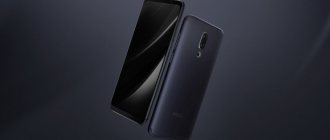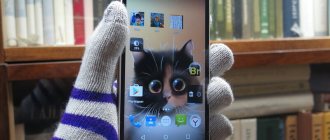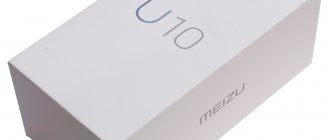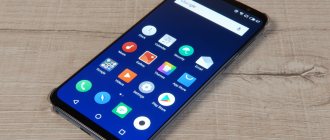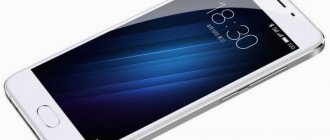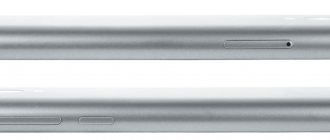Meizu smartphones know how to surprise. In 2020, the Meizu Pro 5 model appears with excellent parameters and a serious drawback - heavy weight and, at that time, a large diagonal. A year later, the company releases a new flagship - Meizu Pro 6. Buyers were expecting a gadget of a similar size or even larger, but with improved parameters. However, the Chinese brand took a different path - the device turned out to be more powerful, but at the same time smaller. Meizu Pro 6 review of characteristics and features will tell you about the model and make it clear whether it is worth the money. At the start of sales, the cost reached 35 thousand rubles, and not every buyer wanted to purchase a Chinese device for that kind of money, especially on credit.
Specifications
Meizu pro 6, which has more powerful characteristics than the previous model, is a device that deserves attention. And the point is not that it is equipped with a productive chipset and does not sag in other parameters, but also in size. For several years now, the trend in the mobile device market has been to increase diagonals. At the same time, there will be buyers who want a fast and compact device. There are only a few devices for such requests. One of them is Meizu Pro 6. The list of characteristics is in the table:
| Options | Meizu Pro 6 |
| Materials | Glass, metal, plastic |
| OS | Android 6.0, Flyme 6.1 |
| Screen | 5.2 inches, SuperAmoled, FHD, 2.5D, 3D Touch Press |
| Chipset | Helio X25, 4*1.4 GHz, 4*2 GHz, 2*2.5 GHz |
| Memory | 4 Gb, 32/64Gb |
| Camera | 21 MP, 5 MP |
| Wireless standards | Wi-Fi, Bluetooth 4.0, LTE, GPS, Glonass |
| Peculiarities | Finger scanner, audio processor |
| battery | 2560 mAh |
| Dimensions and weight | 147.7*70.8*7.2 mm, 160 grams |
Top modification Meizu Pro 6 64 Gb and 4 Gb of RAM. In 2020, this may seem modest, but in 2020, not every flagship offered to buy 128 GB of memory. Otherwise, the device offers modern parameters. The company changed the chipset manufacturer; in Pro 5, the supplier was the Samsung brand. The model has everything you need. How this works together is described in the review below.
Display 3D Press
The Meizu Pro 6 screen has a good diagonal of 5.2″ inches, its resolution is standard Full HD 1920×1080 pixels, and the matrix type is Full HD. The front edge of the device is covered with 2.5D curved glass. The dots per inch density is 441 ppi. The display has a minimum brightness of 4 Nits, which allows you to use it before bed without unnecessary strain on your eyes, and a maximum brightness of 450 Nits.
The screen in Pro 6 received new 3D Press technology: the smartphone display now tracks not only the X and Y coordinates, but also the Z coordinate, which tracks the force of pressing the display. Similar technology is already used in the latest Apple iPhone 6S/6S Plus. Meizu gave a unique name to its display 3D Press instead of the generally accepted Apple trend - 3D Touch. The function currently only works with native Flyme applications.
Equipment
The Meizu Pro 6 smartphone, like most devices in the expensive segment, will not please the user with its equipment. In the box, in addition to the device, the buyer will find a charging unit and cable, instructions, a paper clip for removing the tray, and a warranty card. The model comes in four colors - white, gold, silver and grey. The latter is closer in color to black and is the only option that has a dark front panel. All other modifications have a white frame around the display. The colors look nice, but according to reviews, gold is considered the most popular.
Performance
The Pro 6 Plus is based on an 8-core Exynos 8890 processor; a similar chip is installed in the Galaxy S7, but here it operates at lower frequencies. The new product has 4 GB of RAM built in, and they also promise the imminent release of the older version 6 Plus, which will have 6 GB of RAM and an uncut processor.
In everyday use, the underclocked processor frequencies are absolutely not felt - the smartphone, as befits a flagship, flies: the interface works perfectly smoothly, there are no stutters when surfing heavy Internet pages, any 3D games are launched at maximum speed.
In the benchmark, the Pro 6 Plus scores almost 114 thousand points, in the geekbench - 6 thousand points in multicore and 1737 points in single. The maximum processor heating under load was 35.6 degrees, which is not much. There is no throttling, the chip operates at the same frequencies even during prolonged gaming.
Appearance
Meizu Pro 6 32 Gb is a device in a metal case with plastic inserts on the back panel. The front part is covered with protective glass Gorilla Glass 3. According to engineers, the cover of the device is 98% metal. This can be believed, since Meizu is a brand that gravitates towards the use of metal in devices.
If you look at the smartphone from the front, you get the feeling that this is an Apple iPhone 6s, everything is copied completely, with the only difference being that Apple’s button is round. Meizu traditionally uses the proprietary oval mTouch key version 2.1. There is no point in dwelling on its features separately, since most readers are familiar with the functionality. The button traditionally has a fingerprint scanner built into it. According to reviews, it works quickly and without errors. There are no problems. A neat speaker is located above the display. On either side of it are a camera and a sensor. The latter are the same size and located symmetrically.
At the bottom there is a slot for connecting Type-C, as well as speakers. For some unknown reason, a headphone output was also included here. How convenient this situation is is for each user to judge personally, since opinions differ. At the top end there is a microphone. The back of the device received a round convex camera with a silver rim. Below it is a smaller flash with 10 LEDs of different colors. The center of the flash is black - this is where the laser focusing system is located. On the left side there is a SIM slot; two of them can be installed. The model does not have a slot for a memory card. On the right side is the power button and volume switch.
In terms of ergonomics, the device turned out to be successful. The materials and size of the case make it comfortable for the hand and non-slip. The surface is a little soiled, but this is not critical. The display is protected by glass with a high-quality oleophobic layer. There are no complaints about him. In general, the model has a more pleasant tactile sensation than the company’s previous flagship Pro 5.
Meizu Pro 6 Plus review
August 15, 2018
The Meizu Pro 5 is a great device and when the company introduced its successor, the Pro 6, many fans were disappointed with the specs. Meizu decided to correct the situation and released the Plus version of the smartphone, which received a 5.7″ AMOLED display with a resolution of 1440p, an Exynos chip from Samsung, 4-axis image stabilization, a large battery and a heart rate sensor. What else can surprise Meizu Pro 6 Plus? Read our review.
Characteristics
- Display: 5.7" Super AMOLED with a resolution of 1440p, 515ppi, 3D Press.
- 64GB model: Octa-core Exynos 8890 chipset with four Mongoose cores clocked at 2.0 GHz and four Cortex-A53 cores clocked at 1.5 GHz; Mali-T880 MP10 GPU; 4 GB RAM.
- Model with 128 GB of internal memory: octa-core Exynos 8890 chipset with four Mongoose cores running at 2.3 GHz and four Cortex-A53 cores at 1.6 GHz; Mali-T880 MP12 GPU; 4 GB RAM.
- Main camera: 12-megapixel Sony Exmor RS IMX386 sensor; 1.25µm pixel size, f/2.0 aperture; 4-axis optical image stabilization; phase and laser autofocus; dual-tone ring flash with 10 LEDs, video recording 2160p @ 30fps.
- Front camera: 5 MP, video recording 1080p @ 30fps.
- Connectivity: LTE (450/50 Mbps); two SIM cards; Wi-Fi a/b/g/n/ac; Bluetooth 4.1; NFC; GPS/GLONASS/Beidou; USB Type-C port, USB On-The-Go.
- mTouch button with fingerprint scanner and heart rate sensor.
- Audio chip ADI AD45275, DAC ESS ES9018K2M.
- Battery: 3400 mAh with 24 W mCharge 2.0 (50% charge in 30 minutes).
Unboxing
Meizu's flagship phones always come in premium packaging. The Pro 6 Plus comes in a large black box made of thick plastic. The package includes a USB-C cable, a SIM eject tool, and a 24W power adapter compatible with QuickCharge 2.0.
Design
Meizu Pro 6 Plus has dimensions similar to its predecessor: 155.6 x 77.3 x 7.3 mm. At the same time, it weighs 10 grams less (158 g) - impressive, given the upgraded hardware and larger battery.
Meizu Pro 6 Plus is a thin smartphone that has a stylish aluminum body and a 5.7-inch Super AMOLED display covered with 2.5D glass. Unlike the Pro 6, the Plus version has less rounded corners.
Above the display there is a speaker, a front camera, as well as a pair of sensors and an LED flash.
Below the screen there is a proprietary function button, which has become even better. Firstly, it combines the functions of the Home and Back buttons. Secondly, its surface is also used as a fingerprint scanner. Thirdly, it received an update - a heart rate sensor was built into it.
On the left side of Meizu Pro 6 Plus there is a SIM card slot. You can use two nano SIM cards; the device does not support microSD memory cards. On the right are the volume rocker and the power button. On the top, you'll only find the secondary microphone, while on the bottom, you'll find the headphone jack, primary microphone, USB-C port, and speaker grille.
The metal rear panel houses a 12-megapixel Sony camera, and underneath it is a dual-tone circular flash consisting of 10 LEDs.
Overall, the smartphone has a sophisticated design. Despite the fact that the body is aluminum, the device fits well in the hand and does not slip out.
Display
Meizu Pro 6 Plus returns to the roots of the Pro series - the device received a large 5.7-inch Super AMOLED display from Samsung with Quad HD resolution (1440 x 2560 pixels) and 3D Press function (which recognizes the pressure applied to the display to display the context menu of applications without their launch).
The pixel arrangement is Diamond PenTile, while the density is quite high - 515ppi.
Color reproduction is good, but compared to Pro 5, not ideal. Basic colors (red, green, blue), especially red, are a little oversaturated. The average DeltaE is 6.2, which is not bad. It is possible to adjust the color temperature and thus obtain more accurate colors.
Meizu Pro 6 Plus, good, but not perfect, as in. and thus also peak 13.6 of the red channel. Playing through the color temperature slider in the settings doesn't improve color accuracy, but you can get less bluish whites by going to a general thermal camera. Still, an average of 6.2 isn't bad, and we know many users will appreciate the punchy colors.
Meizu promises a maximum brightness of 430 nits; in fact, in our tests it managed to reach 450 nits.
Readability in bright sunlight is excellent - you will have no difficulty making out what is written on the screen.
Autonomy
The battery capacity of Meizu Pro 6 Plus is 840 mAh larger compared to Pro 6 - a total of 3400 mAh. There is support for the QuickCharge 2.0 fast charging function, which allows you to charge your phone by 50% in half an hour.
In our battery testing, the Meizu Pro 6 Plus performed very well, thanks to its large battery capacity and energy-efficient chipset.
The battery lasts for 16 hours 6 minutes of calls / 15 hours 51 minutes of web surfing / 14 hours 42 minutes of video viewing. In standby mode, the smartphone can work up to 96 hours.
Performance
The Meizu Pro 6 Plus comes in two different versions, both models are based on the Exynos 8890 chipset, which is also the hardware that powers the Samsung Galaxy S7.
The 64GB version of Meizu Pro 6 Plus is equipped with an octa-core Exynos 8890 chipset with four Mongoose cores clocked at 2.0 GHz and four Cortex-A53 cores clocked at 1.5 GHz. The GPU is Mali-T880 MP10. The amount of RAM is 4 GB.
The equipment of the 128 GB version is similar to the Samsung Galaxy S7 edge: eight-core Exynos 8890 processor (4 x Mongoose cores at 2.3 GHz and 4 Cortex-A53 cores at 1.6 GHz), 4 GB of RAM, and is responsible for graphics Mali-T880 MP12.
In the GeekBench 4 single-core test, the Meizu Pro 6 showed a good result, but still came out behind the Samsung Galaxy S7 edge. However, it is worth noting that we have a less powerful 64 GB model in our review.
In the GeekBench 4 multi-core test, the more powerful Mongoose cores come into play. According to the results, the Pro 6 Plus was in the middle of the ranking.
AnTuTu 6 gives a more accurate picture of the overall performance of a smartphone. In this test, the result of the Meizu smartphone is about 14% worse than the Samsung Galaxy S7 edge, which is expected.
The same conclusions can be drawn about the results of testing in BaseMark OS II. The performance of the Pro 6 Plus is close to the S7.
On the graphics side, it was interesting to see how much the lack of two Mali-T880 cores impacts graphics performance. In the GFX 3.1 Manhattan test (1080p offscreen), Meizu Pro 6 Plus with 10 cores is located below the Galaxy S7 edge (E8890) with 12 cores.
Fewer GPU cores also explain the test results in GFX 3.1 Manhattan (onscreen).
Overall, the phone works great, there are no lags or delays. We are confident that the results of the older version will be at the level of the Samsung Galaxy S7 edge (Exynos 8890).
Camera
Meizu Pro 6 Plus uses a 12-megapixel Sony IMX386 sensor (1.25μm pixel size, f/2.0 aperture, 4-axis optical image stabilization, phase detection and laser autofocus system, 10-LED dual-tone ring flash).
The application launches the camera in automatic mode. HDR must be enabled manually; it is not enabled by default. Shooting modes such as Auto, macro, manual, enhancement, panorama, GIF and several others are available. In manual mode, you can set the shutter speed to 20 seconds, adjust ISO and focus (from macro to infinity).
Sample photos taken with the Meizu Pro 6 Plus camera have excellent dynamic range and a very good level of detail. Contrast and white balance are also quite good, although colors are sometimes warmer than they should be. However, there is quite a lot of noise present, and reducing it sometimes affects detail. This mainly shows up in landscape photographs.
HDR mode is designed to give you even wider exposure of a scene. The Meizu Pro 6 Plus does a great job of capturing detail, but if there is enough light, it can result in an unrealistic look. We recommend turning on HDR only if you are not happy with the photos you took in automatic mode.
HDR disabled
HDR enabled
When shooting at night, OIS works great.
Conclusion
The Meizu Pro 6 Plus has everything the original Pro 6 should have - it's a worthy upgrade over the Pro 5: a stunning high-resolution AMOLED screen, a fairly powerful Exynos chipset, a better camera with OIS support, an improved mTouch button and a larger battery. , as well as an aluminum body.
Brand: Meizu
Tags:Meizu,smartphone,flagship,review,Meizu Pro 6 Plus,Meizu Pro 6
Display
The smartphone's matrix is 5.2 inches in size with small frames on the sides. At the release date of the device, this was one of the best parameters in terms of the ratio of the physical size of the screen to the surface of the front panel. The resolution is FHD, which is more than enough for such a diagonal. The screen manufacturer was Samsung; it is no secret that in 2020 to this day their Amoled displays remain the best on the market. Sometimes third-party manufacturers cannot configure the display correctly, but this is not the case. The only point that can make picky buyers scold the company is that at large angles the colors shift to green, but this is more of a nitpick than a real minus.
Meizu left the screen settings from Samsung - you can select the color temperature and also enable eye protection mode. The device behaves great in the sun. The model can work with gestures and also has a smart touch mode. When activated, a dot appears on the screen. Different touches to it are accompanied by certain actions. If you swipe up on the dot, the notification panel will open; if you touch the backlight area once, the screen will go back one menu item.
Another interesting feature of the mobile phone is 3D Press. This is similar to Apple's 3D Touch feature. If the function is enabled, then a certain duration of pressing allows you to perform various types of actions. For example, holding your finger on the “phone” button opens a menu that allows you to add a new number or search for an already stored contact. The pressing force can be adjusted or this mode can be disabled altogether. In fact, there is no special meaning in it; it is rather an interesting opportunity, but not a real assistant in work.
Video review
A detailed description of the Meizu Pro 6 vs Pro 6s battle can be found below:
Reviews
Meizu Pro 6
Alexander: “I spent a long time choosing which smartphone to choose. Not surprising - the purchase is not cheap. I saw the Pro 6 in the showroom and couldn’t take my eyes off it. I bought it instantly and have been using it for over a year. The impressions are extremely positive. High performance, excellent shooting and high-quality music. He earns his money in full.”
Dmitry: “I bought the phone for my wife. I was captivated by the design and how comfortable it fits in my hand. My wife is very pleased and couldn't be happier with the purchase. I recommend it to everyone, it’s an excellent phone!”
Vasilisa: “A friend who ate the dog at Meiza helped with the choice. He said that the phone really claims first place in terms of the combination of performance and design. I didn't deceive you. I love. I recommend ".
Meizu Pro 6s
Natalya: “I’m crazy about my smartphone. Maze has been number 1 on the market for me for many years. In this particular model, I was captivated by the camera – it’s wonderful.”
Andrey: “I saw the 6c model on the counter and didn’t understand what the difference was with the regular six. However, the consultant described everything to me in detail. In principle, the cost of the phones is the same, but the 6c has more chips, so I think the cost is justified.”
Edward: “Um, initially the decision not to release the phone on the European market seemed strange to me, but after a couple of weeks I saw a new product in the store. What can I say, the phone is just super! In no way inferior to the expensive iPhone 6 Plus, but the price is significantly lower.”
The device in operation
Meizu Pro 6 is equipped with a new chipset with 10 cores, which work in two quads and one pair. At the time of release, this is the world's first processor with so many cores. Their work is that the chipset understands the complexity of the task and assigns it to either weaker or more powerful cores. This allows you to save battery, so it turned out to be modest in the device by Chinese standards. The second positive aspect of this load distribution is low heating even at high performance.
The model turned out to be fast in turning pages, animation and displaying information on the display, but the device does not shine in games. Of course, you can run new things on it, but the frame rate most often sags. Meizu Pro 6 scores about 97 thousand points in Antutu, which is not the highest value for a flagship device. At the time of its release, the device was ranked 7th on the list.
The device memory is 32 Gb or 64 Gb with the same 4 Gb RAM option. For 2020, both versions are quite enough for most tasks, but for those who prefer to store a lot of data, it is better to opt for the 64 GB version, since the device does not allow additional use of external memory. The price does not differ much depending on the version - no more than 2 thousand rubles, depending on the seller. In this case, the overpayment is quite justified.
The device's wireless interfaces are quite decent for their time. Bluetooth supports Low Energy mode, that is, the battery does not drain too quickly, and the Wi-Fi module operates in two bands. The connection quality is stable. Searching in navigation systems is carried out quickly and without serious glitches.
⇡#Hardware and performance
Meizu Pro 6 is the first smartphone based on the top Mediatek platform. In this case, it is Helio X25; there is also a version with X20, characterized by a slightly lower clock speed of the cores and graphics subsystem. By the way, there are as many as ten cores here: two Cortex-A72 at 2.5 GHz, four Cortex-A53 at 2 GHz and four more Cortex-A53 at 1.4 GHz. They are divided into three clusters (the so-called Tri-Cluster architecture), which should provide an efficient distribution of tasks: simple tasks are sent to one cluster of cores, while more complex and more power-intensive tasks are distributed across the other two. Technological process – 20 nm.
The platform also runs a Cortex-M4 companion core with a frequency of up to 364 MHz, which is designed to process information from sensors and perform some other functions, such as playing audio in the background.
Graphics subsystem – ARM Mali T800 series with a clock frequency of 850 MHz. Quite a serious chip, but the entire system as a whole suffers from a lack of optimization - this explains the low results in graphics tests (primarily in GFXBench and 3DMark) and, separately, in the WEBXprt benchmark, where Pro 6 showed a very low result, comparable to those , which is shown by mid-level devices. In particular, Xiaomi Mi4i and ASUS Zenfone 2 Laser produce similar numbers.
Another point is the tendency of Meizu Pro 6 to overheat. I encountered this several times during a couple of weeks of testing: the metal smartphone became so hot that it was almost impossible to hold it in your hand, and at the same time refused to perform some simple tasks like launching the camera application. However, after a while it cooled down, not even requiring a reboot, but leaving a bad aftertaste.
Meizu Pro 6, despite the Full HD display, is equipped with 4 GB of RAM - this is more than enough for the needs of the smartphone, it works quickly in the vast majority of situations. Rare unpleasant moments are associated with overheating. However, it’s still not possible to achieve high FPS rates on top-end toys at maximum settings - the flagship Mediatek platform does not reach the level of Snapdragon 820 or Exynos 8890.
The flash memory capacity ranges from 32 to 64 GB depending on the version of the smartphone - there are two on sale to choose from. None of them are microSD friendly - you cannot supplement the built-in storage with a memory card in the Pro 6.
Communications and wireless communications
The part about wireless modules when talking about flagship smartphones can be copied from time to time, but Chinese brands sometimes present surprises - sometimes they suddenly remove NFC, sometimes they forget to support 5 GHz Wi-Fi. In the case of Meizu Pro 6, however, it does without unpleasant discoveries: Bluetooth 4.1, Wi-Fi 802.11ac/b/g/n and work with LTE networks - with a maximum speed of up to 300 theoretical megabits per second (Cat. 6). But there is no support for NFC and the 20th band, which is important for Russia, on which, in particular, Beeline operates. Subscribers of this operator - owners of Meizu Pro 6 - will have problems when using LTE. The smartphone works with two SIM cards, there is only one radio module - Dual Standby mode is in effect: when a call arrives on one SIM card, the second one is temporarily disabled. There is no infrared port on Meizu Pro 6.
| Meizu Pro 6, AndroiTS GPS Test results | ||
The navigation module works with GPS (with A-GPS support), GLONASS, BeiDou. And it works very well: it takes about 10 seconds to search for satellites, after which the smartphone is ready to guide you on the map, communicating with 14 satellites and navigating by 13 of them; Over time, this number will, of course, increase. The accuracy is particularly impressive – up to one meter.
Camera
The model received a main camera from Sony, it has 6 lenses, a resolution of 21 megapixels, and has phase and laser focusing. The latter, according to the developers, has a range 4 times greater than before. The camera turned out to be a good model, but only in comparison with the previous device. Experts note that focusing has become faster, image depth has improved, there is less noise, and the image capture angle has increased slightly. However, it is not worth comparing the photo capabilities of Meizu Pro 6 with the Samsung S7 or LG G4 released at the same time. The device is clearly losing. If we refuse comparison, the device takes decent pictures at any time of the day. The model can record video in 4K; the disadvantage of recording is the small angle of image capture.
The front module is 5 megapixels, it is nothing supernatural. It takes decent pictures and allows you to record good quality videos. The set of settings is standard - fully automatic or manual modes.
⇡#Camera
Meizu Pro 6 uses new modules for both cameras: the front one is 5 megapixels, the main one is 21. First, let's talk about the main one. In addition to resolution, it is worth mentioning the aperture (f/2.2), equivalent focal length (31 mm) and the physical size of the sensor (quite decent 1/2.4''). A hybrid automatic focusing system is used, combining the phase focusing method with the laser; Meizu's signature feature is a large circular flash with ten diodes, providing uniform and powerful illumination.
The camera can do everything you need: capture HDR, take panoramas, “improve” portraits using anti-aliasing, and also apply various color filters if you don’t like a million special applications from Google Play or a set of filters from Instagram. There are basic manual settings.
| Meizu Pro 6 camera interface | ||
The camera app in Flyme is still underwhelming. At first glance, everything is standard, there are even nice options in the form of a virtual horizon displayed directly on the shutter icon, and a grid that allows you to comfortably frame your frame. You can quickly jump between the main and front cameras by swiping up from the bottom edge of the screen. But the frustrating thing is that you can’t quickly switch between photos and videos—to do this, you definitely need to go into the settings. I’m also not happy about the interface that doesn’t change when shooting in landscape orientation – it’s really inconvenient.
In the pictures below you can see how the Meizu Pro 6 camera performed in the same situations in comparison with the camera of one of the best smartphones in terms of photography - the LG G5 se.
| On the left is a photo taken on LG G5 se, on the right is a photo taken on Meizu Pro 6 | ||
| On the left is a photo taken on LG G5 se, on the right is a photo taken on Meizu Pro 6 | ||
| On the left is a photo taken on LG G5 se, on the right is a photo taken on Meizu Pro 6 | ||
| On the left is a photo taken on LG G5 se, on the right is a photo taken on Meizu Pro 6 | ||
Meizu Pro 6 really shows itself very well - with correct white balance, quite rich, but at the same time natural color reproduction, and work in difficult lighting conditions that is quite normal for a flagship smartphone. True, shooting in the twilight could have been better: there is not enough detail, noise is too noticeable. Separately, I would like to note the high-quality macro photography - good sharpness.
Meizu Pro 6-camera gallery
View all images (30)Meizu Pro 6 can record 4K video - this is now practically the standard for top-end smartphones.
The front camera is not a strong point of the Meizu Pro 6. Five megapixels, without autofocus and flash. You can take selfies, but almost all competitors can do it better.
Autonomous operation
Meizu Pro 6 uses a 9.72 Wh battery (2560 mAh, 3.8 V). Not the most capacious battery, but for a 5.2-inch gadget it is, in principle, enough. The smartphone handles the working day quite confidently and even survives until the night - there is no need to rush headlong in search of an outlet. Yes, you need to charge it strictly every day, but this is now the norm.
In our traditional test with HD video playback at maximum brightness with wireless modules turned on and active updates, Meizu Pro 6 lasted more than 11 hours - simply excellent, better than most competitors. The device lost only to the best in this discipline: Samsung Galaxy S7 and Moto X Force.
The proprietary mCharge 3.0 charging technology allows you to recharge the device by 26% in 10 minutes, and 100% in an hour. Quite impressive. I will add that USB Type-C with support for USB 3.1 is used as a charging connector - very high data transfer speeds are provided, but there are also some problems if you forget the cable at home. On the other hand, most flagships are now available with USB Type-C, so soon the problem of finding a cable will disappear.
Software
The model runs on the 6th generation Android operating system and traditionally has its own Flyme 5.2 shell installed on top, which makes you forget that the device is even on Android. The interface is very different from what Android owners are used to. At the same time, with the update to version 5 it became better. The presence of a branded button designed for gestures led to the fact that the entire system was very much oriented towards this. This can hardly be called a minus, but for those who are not used to Maze devices, it took a long time to master the capabilities of the phone. With the update, the device has become more loyal to new users and this is a clear plus, since ease of use is an important parameter.
Along with the improved interface, the phone now has more options for personalization, as well as security settings, power settings, and other useful utilities. The result is that the shell has become more convenient, but has not lost its attractive appearance. In terms of response, there are no problems in operation, everything works smoothly, without brakes or glitches, this is also pleasant, since despite the prevalence of Chinese phones, many buyers are still waiting for a catch in the operation of the OS.
About the battery
If we talk about the description of the battery, then the Pro version of this phone has a non-removable battery with a capacity of 2560 mAh, and the Plus version has a 3400 mAh battery. But we will test the regular model. When working with the device, the battery lasts for about 16-17 hours. In a more gentle mode, the device will easily last a day on one battery charge. And if you turn off everything except data synchronization via Wi-Fi, you can count on two days. The phone can work up to 13 hours in continuous talk mode.
If you watch videos in FullHD or 4K format, you can count on 9 hours of continuous viewing. And if you play, then for 3.5 hours. If you decide to listen to music through the speaker, you can do this for 50 hours. Interestingly, the charging speed of the phone is excellent. It charges to 100 percent in just 1 hour. This became possible due to the support of the mCharge 3.0 function with precise energy distribution. Thanks to it, the smartphone not only charges 20 percent more efficiently than competing solutions, but also heats up 5 degrees less.
An equally interesting device from Meizu is in our other review -
[wp_ad_camp_1]
Sound and autonomy
Regarding sound, Meizu has always been one of the leading manufacturers. They not only install high-quality speakers with amplifiers, but also equip their gadgets with a separate music chip. Music lovers usually like the result and reviews of the sound of smartphones are always positive. This model has a newer sound processor than the Pro 5, and the volume has also increased. What’s nice is that the device does not choke, does not wheeze, and generally does not cause any unpleasant sensations when listening to music. The sound in the headphones is of high quality; experts note that the device in this regard looks better than the Samsung S6 and is quite comparable to the S7. An interesting feature of the model is the speaker heating control. The chipset receives information about its temperature and prevents the coil from overheating, which eliminates the possibility of its failure.
The model's battery has a capacity of 2560 mAh, despite the low figure for a Chinese smartphone, it can withstand about 17 hours of serious loads - Internet use, correspondence and calls. If you take care of the battery, the work can be extended for a day. The device lasts four hours in toys, and plays movies for nine hours. A smartphone will allow you to enjoy music continuously for more than two days.
The model received its own mCharge fast charging technology, which differs from Quick Charge in speed. The smartphone charges 100% via its original charging unit and cable in exactly one hour. This is an excellent indicator, and at the same time, an assessment of the technology showed that the heating of the battery during charging is 5 degrees less than that of competitive fast charging options. This is definitely an advantage of the device. In this case, the presence of such a function is beneficial and not an advertising feature. The device does not provide wireless charging, but even in 2020 there are doubts about its necessity.
Speaker, sound quality
Sound quality in headphones is traditionally the strong point of Meizu smartphones. The Pro 6 Plus features a dedicated ESS ES9018K2M audio chip and an ADI AD45275 amplifier powered by Rybicon capacitors. These are Hi-Fi level solutions that can reveal even the highest quality headphones.
The sound in the headphones amazes you from the very first minutes of listening to music. The sound is high quality, lows and highs are perfectly balanced, the stage and sound detail are pleasing. The volume reserve is extremely large; the Pro 6 Plus can handle even high-impedance headphones.
The main speaker of the smartphone is not bad, it is loud and very clear - there is no metallic tint to the sound, there is even a slight hint of low frequencies. Suitable for viewing video content and signaling calls and notifications.
Bottom line
Today you can buy Meizu Pro 6 for 21-23 thousand, depending on the seller. The model is temporarily not for sale on Aliexpress. The price for the device is adequate and in terms of parameters it is a current device for 2019. The only point is that there are fresh devices from competitors with similar or better parameters in the same price segment. However, they will have a larger diagonal. If this is critical, then the device is the best option; if not, then for the same price you can buy Pocofone F1, which is better by all criteria.
operating system
After testing Meizu Pro 6 Plus in Antutu, we move on to the operating system. This smartphone is installed with the familiar Android operating system version 6.0.1, and Flyme OS version 6 serves as the proprietary shell.
The new version of the shell has added a heart rate reading function, which will be very useful for playing sports or for simply monitoring your health. Of course, more standard features are also available, such as gesture support, app sorting, simplified interface mode, and much more.
Flyme is not overloaded with various pre-installed programs; instead, Meizu offers to use the Editor's Choice program and download to the phone all the most popular programs among users today at its own discretion. The only negative that can be highlighted is the lack of services from Google, which the user will have to install manually.
Wireless communications and Internet
We didn't have any connection problems while testing the Pro 6 Plus. The smartphone confidently picks up both GSM network signals and 3G/LTE networks. There are no complaints about geopositioning, GPS satellites are located quickly, synchronization is stable and accurate.
The smartphone has an NFC chip, supports the Type-C interface (USB 3.0 version) and connects adequately to any external devices.
Video review of Meizu Pro 6 Plus
Competitors, conclusions
To conclude the review, let’s say that we have extremely good impressions of the Meizu Pro 6 Plus. This is a cool and easy-to-use smartphone, no matter how you look at it. Its only drawback is the lack of a slot for a memory card; you will have to be content with the built-in 64 or 128 GB.
Now about the price. Pro 6 Plus has become the company's most expensive smartphone; in Russia it sells for 34-39 thousand rubles for different versions, which puts it on par with very tough competitors - One Plus 3T 128GB (36 thousand rubles), Nubia Z11 64 GB (39 thousand), ZTE Axon 7 64GB (40 thousand). Also, as an alternative, you can consider the Xiaomi Mi5S, the 128GB version of which can be purchased for 25 thousand, and the Galaxy S7, available at a price of just over 30 thousand for the 32 GB version, which has a slot for a flash drive.
Compared to its competitors, the advantages of the Pro 6 Plus are not so obvious, and only time will tell whether the new product from Meizu will not get lost among other flagships. But, in general, the smartphone turned out to be successful, and we confidently recommend it for purchase.
Price and characteristics
Pro 6 Plus is available in two versions - with 4 GB of RAM and an Exynos 8890 processor with a clock frequency reduced to 1.5-2.0 GHz, and 6 GB of RAM with an uncut chipset (1.6-2.4 GHz). In Russia, only the younger version of the smartphone is currently available; you can buy it at a price of 34 thousand rubles, but soon they promise to begin deliveries of the older version at a price of 39 thousand.
Characteristics:
- screen: 5 inches, Super-AMOLED matrix 1920*1080 px;
- chipset: Exynos 8890 (8 cores, 1.5-2 GHz) with Mali T880-MP10 graphics accelerator;
- RAM: 4/6 GB;
- internal memory: 64/128 without memory card slot;
- camera: rear – 12 MP, selfie – 8 MP;
- battery: 3400 mAh.
The dimensions of the smartphone are 71*148*7.25 mm, weight – 160 grams. Body colors are gold, gray and black.
